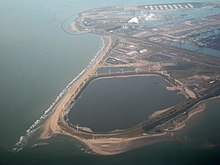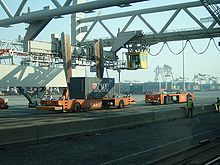Port of Rotterdam
| Port of Rotterdam | |
|---|---|
 | |
| Location | |
| Country | Netherlands |
| Location | Rotterdam |
| Coordinates | 51°53′06″N 4°17′12″E / 51.8850°N 4.2867°E |
| Details | |
| Opened | 14th century |
| Size of harbor | 5,257 ha (12,990 acres) |
| Land area | 5,299 ha (13,090 acres) |
| Size | 10,556 ha (26,080 acres) |
| Employees | 1,100 (2016)[1] |
| Chief Executive Officer | Allard Castelein |
| Statistics | |
| Vessel arrivals | |
| Annual cargo tonnage | |
| Annual container volume | |
| Annual revenue | |
| Net income | |
| Website www.portofrotterdam.com | |
The Port of Rotterdam is the largest port in Europe, located in the city of Rotterdam, Netherlands. From 1962 until 2004 it was the world's busiest port, now overtaken first by Singapore and then Shanghai. In 2011, Rotterdam was the world's eleventh-largest container port in terms of twenty-foot equivalent units (TEU) handled[3] (2009: tenth; 2008: ninth, 2006: sixth). In 2012 Rotterdam was the world's sixth-largest port in terms of annual cargo tonnage.[2]
Covering 105 square kilometres (41 sq mi), the port of Rotterdam now stretches over a distance of 40 kilometres (25 mi). It consists of the city centre's historic harbour area, including Delfshaven; the Maashaven/Rijnhaven/Feijenoord complex; the harbours around Nieuw-Mathenesse; Waalhaven; Vondelingenplaat; Eemhaven; Botlek; Europoort, situated along the Calandkanaal, Nieuwe Waterweg and Scheur (the latter two being continuations of the Nieuwe Maas); and the reclaimed Maasvlakte area, which projects into the North Sea.
Rotterdam consists of five distinct port areas and three distribution parks that facilitate the needs of a hinterland with 40,000,000 consumers.
Contents
Nieuwe Waterweg[edit]
In the first half of the 19th century the port activities moved from the centre westward towards the North Sea. To improve the connection to the North Sea, the Nieuwe Waterweg ("New Waterway"), a large canal, was designed to connect the Rhine and Meuse rivers to the sea. The Nieuwe Waterweg was designed to be partly dug, then to further deepen the canal bed by the natural flow of the water. Ultimately however, the last part had to be dug by manual labour as well. Nevertheless, Rotterdam from then on had a direct connection between the sea and harbour areas with sufficient depth. The Nieuwe Waterweg has since been deepened several times. It was ready in 1872 and all sorts of industrial activity formed on the banks of this canal.
Europoort and Maasvlakte extensions[edit]

Over the years the port was further developed seaward by building new docks and harbour-basins. Rotterdam's harbour territory has been enlarged by the construction of the Europoort (gate to Europe) complex along the mouth of the Nieuwe Waterweg. In the 1970s the port was extended into the sea at the south side of the mouth of the Nieuwe Waterweg by completion of the Maasvlakte (Meuse-plain) which was built in the North Sea near Hoek van Holland.
In the past five years the industrialised skyline has been changed by the addition of large numbers of wind turbines taking advantage of the exposed coastal conditions. The construction of a second Maasvlakte received initial political approval in 2004, but was stopped by the Raad van State (the Dutch Council of State, which advises the government and parliament on legislation and governance) in 2005, because the plans did not take enough account of environmental issues. On 10 October 2006, however, approval was acquired to start construction in 2008, aiming for the first ship to anchor in 2013.
Characteristics[edit]

Most important for the port of Rotterdam is the petrochemical industry and general cargo transshipment handlings. The harbour functions as an important transit point for transport of bulk and other goods between the European continent and other parts of the world. From Rotterdam goods are transported by ship, river barge, train or road. Since 2000 the Betuweroute, a fast cargo railway from Rotterdam to Germany, has been under construction. The Dutch part of this railway opened in 2007. Large oil refineries are located west of the city. The river Maas and Rhine also provide excellent access to the hinterland.
24 metre draft[edit]
The EECV-quay of the port has a draft of 24 metres (78 feet),.[4] This made it one of only two available mooring locations for one of the largest bulk cargo ships in the world, the iron ore bulk carrier MS Berge Stahl when it is fully loaded, along with the Terminal of Ponta da Madeira in Brazil,[5] until the opening of a new deep-water iron ore wharf at Caofeidian in China in 2011.[6] The ship's draft of 23 meters (75 feet) leaves only 1 metre (3 feet) of under keel clearance, therefore it can only dock in a restricted tidal window.[7] Such ships must travel in the Eurogeul.
Robotic container operations[edit]
This section does not cite any sources. (June 2011) (Learn how and when to remove this template message) |
Much of the container loading and stacking in the port is handled by autonomous robotic cranes and computer controlled chariots. The ECT pioneered the development of terminal automation. At the Delta terminal, the chariots—or automated guided vehicles (AGV)—are unmanned and each carries one container. The chariots navigate their own way around the terminal with the help of a magnetic grid built into the terminal tarmac. Once a container is loaded onto an AGV, it is identified by infrared "eyes" and delivered to its designated place within the terminal. This terminal is also named "the ghost terminal".[8]
Unmanned Automated Stacking Cranes (ASC) take containers to/from the AGVs and store them in the stacking yard. The newer Euromax terminal implements an evolution of this design that eliminates the use of straddle carriers for the land-side operations.
Administration[edit]

The port is operated by the Port of Rotterdam Authority, originally a municipal body of the municipality of Rotterdam, but since 1 January 2004, a government corporation jointly owned by the municipality of Rotterdam and the Dutch State.[9]
Flood barriers[edit]
This section does not cite any sources. (June 2011) (Learn how and when to remove this template message) |
The port of Rotterdam and its surrounding area is susceptible to a storm surge from the North Sea. In the Delta Works flood protection plan various options have been considered for protecting Rotterdam. Finally a unique design was built, the Maeslantkering. This flood barrier consists of two huge doors that normally rest in a dry dock besides the Nieuwe Waterweg. When a flood of 3 metres (9.8 ft) above NAP (mean sea level) is predicted the gates are floated into position, like caissons, and sunk in place. When the water level recedes enough to open the gates, they are floated back into their docks. Another barrier, the Hartelkering, is situated in the Hartelkanaal.
Sustainability[edit]
The Port of Rotterdam aims to be emission-less by the year 2050.[10]
Map of port[edit]
See also[edit]
References[edit]
- ^ About the Port Authority portofrotterdam.com
- ^ a b "The world's 10 biggest ports". ship-technology.com. Retrieved 2014-03-17.
- ^ a b Top 50 World Container Ports. World Shipping Council
- ^ "Port of Rotterdam: Iron Ore", archived from the original on 2006-11-14
- ^ "Machine Support services on world's largest dry bulk carrier" Machine Support News
- ^ 曹妃甸港首次接卸30万吨以上铁矿石巨轮, 2011-10-31, archived from the original on 2012-04-26
- ^ RWS Noordzee: Tidal-window advice, Dutch Archived 9 October 2006 at the Wayback Machine
- ^ https://www.youtube.com/watch?v=nSjLzte1_ps
- ^ "Company Profile". Archived from the original on 5 March 2010. Retrieved 27 April 2010.
- ^ "Duurzaamheid". portofrotterdam.com. Port of Rotterdam. Retrieved January 11, 2018.
External links[edit]
| Wikimedia Commons has media related to Ports and harbours in Rotterdam. |

.png/220px-Satellite_image_of_Europoort%2C_Netherlands_(4.25E_51.90N).png)

